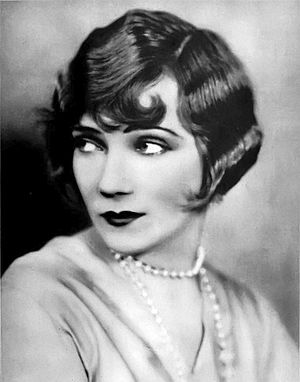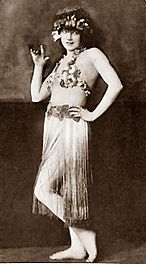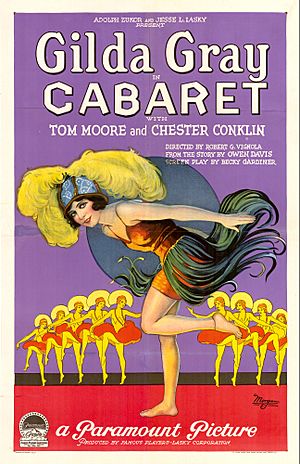Gilda Gray facts for kids
Quick facts for kids
Gilda Gray
|
|
|---|---|

Gray c.1920
|
|
| Born |
Marianna Michalska
October 25, 1895 Rydlewo, German Empire (present-day Poland)
|
| Died | December 22, 1959 (aged 64) Los Angeles, California, U.S.
|
| Resting place | Holy Cross Cemetery, Culver City, USA |
| Occupation | Dancer, actress |
| Years active | 1918–1958 |
| Known for | Popularizing the "shimmy" |
| Spouse(s) |
John Gorecki
(m. 1910; div. 1923)Gaillard T. "Gil" Boag
(m. 1923; div. 1929)Hector Briceño de Saa
(m. 1933; div. 1938) |
| Children | 1 |
Gilda Gray (born Marianna Michalska; October 25, 1895 – December 22, 1959) was a famous Polish-American dancer and actress. She became well-known for making a dance called the "shimmy" very popular. This dance was a big hit in movies and theater shows during the 1920s.
Contents
Early Life and the Shimmy Dance
Gilda Gray was born Marianna Michalska in Poland. In 1903, when she was young, she moved to the United States with her parents. She had a sister named Josephine.
When she was about 14 or 15, Gilda married John Gorecki. He was a concert violinist. They had one son, who later became a bandleader named Martin Gray. Gilda and John divorced in 1923.
How the Shimmy Became Famous
Gilda Gray is often credited with introducing the shimmy dance to American audiences in 1919. However, the dance move was already known before she became famous for it.
Gilda said she accidentally invented the shimmy while dancing. She claimed she was "shaking her chemise" (a type of underwear), and her Polish accent made it sound like "shimee." This story helped make the dance even more popular.
Gilda also said the shimmy dance came from Native American traditions. She mentioned studying their dances for a long time. She believed the original Native American dance, called "Shima Shiwa," was the true source of the shimmy.
Gilda Gray's Career in Entertainment
Gilda wanted to continue her dancing career. She moved to Chicago, where a talent agent named Frank Westphal discovered her. He took her to New York and introduced her to singer Sophie Tucker. Sophie suggested Gilda change her first name to Gilda.
By 1919, Gilda was performing in a show called The Gaieties of 1919. In 1920, she got a new manager, Gil Boag. She was then hired by Florenz Ziegfeld to perform in the 1922 Ziegfeld Follies. Her shimmy dance became a huge national sensation.
From Vaudeville to Film Star
After divorcing her first husband, Gilda married Gil Boag in 1923. She brought her successful vaudeville act to Hollywood, California. Vaudeville was a type of theater show with many different acts.
Gilda soon left vaudeville to become a movie star. Between 1919 and 1936, she made several films. In every movie, she performed her famous shimmy dance.
Jesse Lasky signed her to a contract with Paramount Pictures. With Paramount, she made Aloma of the South Seas in 1926. This movie was very successful, earning a lot of money. Gilda also promoted the film by doing the shimmy dance in person. In 1927, she made two more movies: The Devil Dancer and Cabaret.
Gilda and Gil Boag divorced in 1929.
Challenges and Later Life
When the stock market crashed in 1929, Gilda Gray lost most of her money. However, she found work dancing at the Palace Theater in New York. She also performed on stage in Cleveland.
She tried to make a comeback, but health problems made it difficult. In 1931, she had a heart attack. In 1933, she married Hector Briceño de Saa, a diplomat from Venezuela. They separated two years later and divorced in 1938.
Gilda Gray: A Polish Patriot
During World War II, Gilda Gray worked hard to help Poland. She raised money for her home country. In 1953, a TV show called This Is Your Life featured her story. The show highlighted her bravery in helping six Polish citizens come to America during the Cold War. Gilda also paid for their education.
Poland honored her with a special decoration for her dedication and help to her countrymen and country.
Death
Gilda Gray passed away on December 22, 1959, at the age of 64. She had a second heart attack. At the time of her death, she was again facing financial difficulties. The Motion Picture & Television Fund helped pay for her funeral.
Filmography
| Year | Title | Role | Notes |
|---|---|---|---|
| 1919 | A Virtuous Vamp | Minor Role | |
| 1921 | Girl with the Jazz Heart | ||
| 1923 | Lawful Larceny | Dancer | |
| 1926 | Aloma of the South Seas | Aloma | |
| 1927 | Cabaret | Gloria Trask | |
| 1927 | The Devil Dancer | Takla (The Devil Dancer) | |
| 1929 | Piccadilly | Mabel Greenfield | |
| 1931 | He Was Her Man | Frankie | short |
| 1936 | The Great Ziegfeld | ||
| 1936 | Rose-Marie | Belle | final film role |
Plays
- Music Box Revue (1921)
- Ziegfeld Follies (1922)
- Devil Dancer Play (1927)
Images for kids
See also
 In Spanish: Gilda Gray para niños
In Spanish: Gilda Gray para niños





